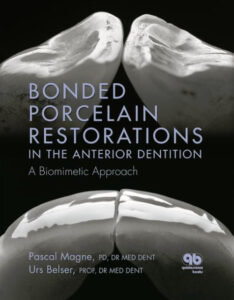A must have for all Biomimetic Dentists
Today we want to take time to talk about our mentor and dear friend, Pascal Magne. In dental school, Pascal changed the way we see and practice dentistry. Every year, he continues to educate both dental students and established practitioners with his passion and enthusiasm for the finest dentistry. His research, education, and textbook have created the strong support for Biomimetic dentistry we see today, with an ever-growing group of dentists becoming trained every year. Respectfully, he has earned the title as the father of Biomimetic Dentistry. His textbook is going on its 12th year of publication as of 2014, every bit as valid today as the day it was written. With all the information provided in this his textbook, he is a mentor to all of us aspiring to do better dentistry.
There are no other textbooks like this in dentistry and every biomimetic dentist needs to have this on their bookshelf. A thorough appreciation of the intact tooth is central to any successful restorative technique and this book will help you realize this fundamental concept. We must accept that we can not improve on nature’s model and focus our attention on the best biomimetic dentistry possible.
The Biomimetic Principle

The core philosophy of this book is the biomimetic principle – the idea that the intact tooth is the ideal model for reconstruction and success. The biomimetic approach is conservative and preserves the biology (vitality) of the tooth. This is in sharp contrast to the traditional dentistry which utilizes porcelain-fused to metal (PFM) restorations. The PFM restoration utilizes a metal casting which is in no way biomimetic. The high elastic modulus of the metal coping removes the dampening and stress absorbing capability of the dentin layers and results in damaging concentration of forces in non-desirable areas. In contrast, the biomimetic approach restores the damaged tooth structure conservatively, preserving all intact tooth structure. In a biomimetic restoration, the dental tissues are returned to full function through a hard tissue bond that allows functional stresses to pass through the tooth.
Understanding Natural Teeth as the Ideal Model for Biomimetic Dentistry
Biomimetics in restorative dentistry starts with an understanding of hard tissue structure and related stress distributions within the intact tooth. This is the focus of the opening chapter of the book, which is the result of research conducted by Pascal Magne.
Dr. Magne spent 2 years as a visiting associate professor at the Minnessota Dental Research center for Biomaterials and Biomechanics at the University of Minnesota. In this environment, many of the ideas presented in this revolutionary text book were developed and tested. Pascal spent much of his time in Minnesota performing studies on how natural teeth concentrate stress and strain under loads. Using finite element analysis, the location and amount of stress accumulation was modeled. The findings from his research have elucidated our understanding of the intact tooth, and drawn focus to the intimate and complex relationship between enamel, dentin, and the DEJ (interPHASE). With a thorough understanding of the intact tooth, restorative techniques can be evaluated in their ability to restore teeth back to original function.
In order to properly restore, we must study the intact tooth in all its complexity. The natural tooth is the perfect model for us to replicate.

You’re so cool! I don’t suppose I’ve truly read something luke that before.
So nic to discover somebbody with some genuine thoughts on this issue.
Seriously.. many thanks foor starting this up.
This website is something that iss needed on the web, someone with a
bit of originality!